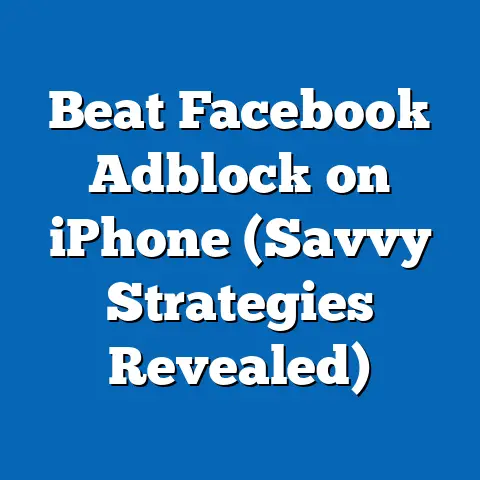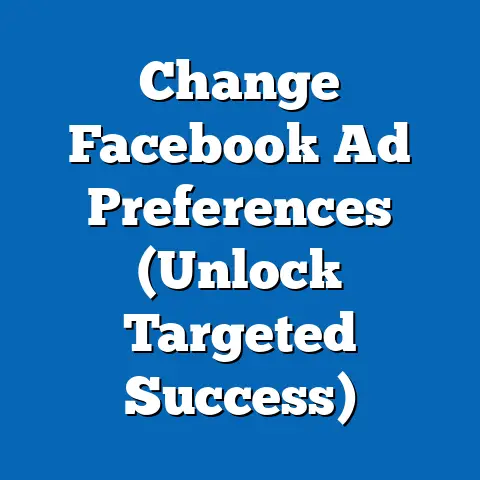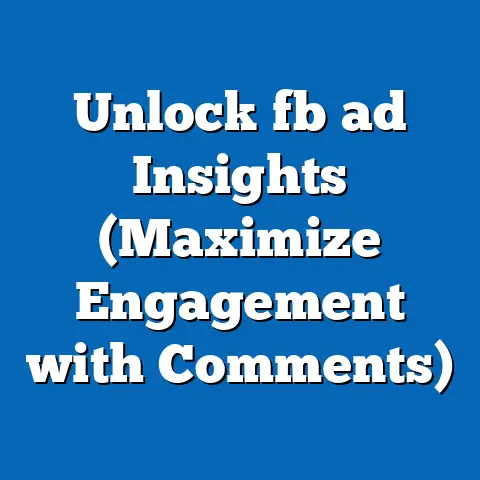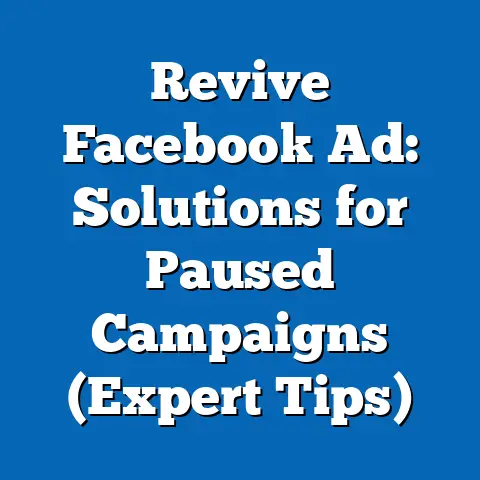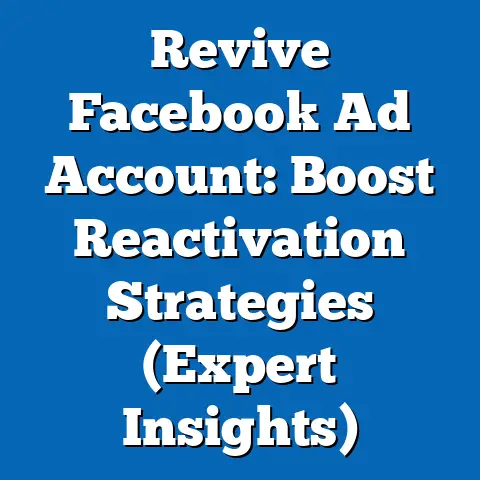Protect Business from Facebook Scam Ads (Essential Tactics)
The digital world offers unprecedented opportunities for businesses to connect with customers, but it also comes with its share of risks. One of the most pervasive and potentially damaging threats is the rise of scam ads on platforms like Facebook. In 2022 alone, Facebook reported taking action against over 1.7 billion fake accounts, many of which were linked to fraudulent advertising campaigns that cost businesses millions. I’ve seen firsthand how these scams can devastate a company, not just financially but also in terms of its hard-earned reputation. That’s why I’m writing this guide – to arm you with the knowledge and strategies you need to protect your business from the ever-evolving threat of Facebook scam ads.
Understanding Facebook Scam Ads
Before we dive into the tactics for protecting your business, it’s crucial to understand what exactly constitutes a scam ad on Facebook. These aren’t just poorly designed or slightly misleading ads; they are deliberately deceptive campaigns designed to defraud users.
Definition of Scam Ads
A scam ad on Facebook is any advertisement that uses deceptive or fraudulent tactics to mislead users for financial gain or other malicious purposes. These ads can take many forms, but some of the most common include:
Phishing Schemes: These ads often mimic legitimate websites or brands to trick users into entering their personal or financial information. For instance, an ad might look like a login page for a popular bank, asking users to enter their username and password. I remember a friend who nearly fell victim to one of these; luckily, she noticed the slightly off URL just in time.
Counterfeit Products: Scam ads frequently promote fake or imitation products, often at drastically reduced prices. These ads lure in unsuspecting customers who believe they are getting a great deal on a genuine item, only to receive a cheap imitation or nothing at all. I once ordered what I thought was a designer handbag, only to receive a poorly made knockoff that fell apart within weeks.
Fraudulent Services: These ads offer services that are either non-existent or misrepresented. Examples include fake debt relief programs, bogus investment opportunities, or sham online courses. These scams often target vulnerable individuals who are desperate for help or looking to make quick money.
“Get Rich Quick” Schemes: These ads promise unrealistic financial returns with little to no effort. They often involve pyramid schemes, multi-level marketing scams, or fake cryptocurrency investments. I’ve seen countless ads promising overnight riches, and they always raise red flags.
Clickbait and Misleading Content: While not always directly fraudulent, these ads use sensational headlines and deceptive images to lure users into clicking on them. The content they lead to is often irrelevant, low-quality, or even malicious.
Phishing Schemes: These ads often mimic legitimate websites or brands to trick users into entering their personal or financial information. For instance, an ad might look like a login page for a popular bank, asking users to enter their username and password. I remember a friend who nearly fell victim to one of these; luckily, she noticed the slightly off URL just in time.
Counterfeit Products: Scam ads frequently promote fake or imitation products, often at drastically reduced prices. These ads lure in unsuspecting customers who believe they are getting a great deal on a genuine item, only to receive a cheap imitation or nothing at all. I once ordered what I thought was a designer handbag, only to receive a poorly made knockoff that fell apart within weeks.
Fraudulent Services: These ads offer services that are either non-existent or misrepresented. Examples include fake debt relief programs, bogus investment opportunities, or sham online courses. These scams often target vulnerable individuals who are desperate for help or looking to make quick money.
“Get Rich Quick” Schemes: These ads promise unrealistic financial returns with little to no effort. They often involve pyramid schemes, multi-level marketing scams, or fake cryptocurrency investments. I’ve seen countless ads promising overnight riches, and they always raise red flags.
Clickbait and Misleading Content: While not always directly fraudulent, these ads use sensational headlines and deceptive images to lure users into clicking on them. The content they lead to is often irrelevant, low-quality, or even malicious.
Recent Trends
Scammers are constantly evolving their tactics to bypass Facebook’s security measures and exploit vulnerabilities. Keeping up with the latest trends is essential for staying one step ahead.
AI-Generated Content: With the rise of artificial intelligence, scammers are now using AI to create more convincing and sophisticated ads. This includes AI-generated images, videos, and text that are difficult to distinguish from legitimate content. I’ve noticed a significant increase in the quality of fake product ads, thanks to AI.
Deepfakes: Deepfake technology allows scammers to create realistic-looking videos of people saying or doing things they never actually did. This can be used to promote fraudulent products, endorse fake services, or spread misinformation.
Targeting Vulnerable Groups: Scammers are increasingly targeting specific demographic groups who are more susceptible to their schemes, such as seniors, students, or people with financial difficulties. I’ve seen ads that specifically target elderly individuals with promises of easy money or free healthcare.
Exploiting Current Events: Scammers often capitalize on current events or trending topics to create timely and relevant ads. For example, during the COVID-19 pandemic, there was a surge in scam ads offering fake cures, bogus vaccines, and fraudulent financial assistance programs.
Impersonation of Trusted Sources: Scammers frequently impersonate trusted sources, such as government agencies, reputable companies, or well-known individuals. This can make their ads seem more legitimate and increase the likelihood that users will fall for their schemes.
AI-Generated Content: With the rise of artificial intelligence, scammers are now using AI to create more convincing and sophisticated ads. This includes AI-generated images, videos, and text that are difficult to distinguish from legitimate content. I’ve noticed a significant increase in the quality of fake product ads, thanks to AI.
Deepfakes: Deepfake technology allows scammers to create realistic-looking videos of people saying or doing things they never actually did. This can be used to promote fraudulent products, endorse fake services, or spread misinformation.
Targeting Vulnerable Groups: Scammers are increasingly targeting specific demographic groups who are more susceptible to their schemes, such as seniors, students, or people with financial difficulties. I’ve seen ads that specifically target elderly individuals with promises of easy money or free healthcare.
Exploiting Current Events: Scammers often capitalize on current events or trending topics to create timely and relevant ads. For example, during the COVID-19 pandemic, there was a surge in scam ads offering fake cures, bogus vaccines, and fraudulent financial assistance programs.
Impersonation of Trusted Sources: Scammers frequently impersonate trusted sources, such as government agencies, reputable companies, or well-known individuals. This can make their ads seem more legitimate and increase the likelihood that users will fall for their schemes.
One notable scam that made headlines recently involved a series of ads impersonating Elon Musk and promoting fake cryptocurrency investments. These ads used deepfake videos of Musk endorsing the scheme, convincing many unsuspecting users to invest their money, only to lose it all.
The Impact of Scam Ads on Businesses
The consequences of scam ads extend far beyond individual victims. Businesses can suffer significant financial losses, damage to their brand reputation, and erosion of customer trust.
Financial Loss
While individual users are often the direct victims of scam ads, businesses can also incur significant financial losses as a result.
Direct Losses: If a scammer impersonates your business and runs fraudulent ads, you may be held liable for the damages caused to customers who fall victim to the scheme. This can result in costly lawsuits and settlements. I know of one small business that had to shut down after being sued for a scam ad that used their logo without their knowledge.
Increased Advertising Costs: When scam ads proliferate on Facebook, it can drive up advertising costs for legitimate businesses. This is because the increased competition for ad space makes it more expensive to reach your target audience. I’ve seen some businesses report a 20-30% increase in their advertising costs due to scam ads.
Loss of Sales: If customers lose trust in your brand due to scam ads, they may be less likely to purchase your products or services. This can lead to a significant decline in sales and revenue. I’ve heard stories of businesses experiencing a 50% drop in sales after being targeted by a scam ad campaign.
Legal and Compliance Costs: Dealing with the fallout from scam ads can require significant legal and compliance resources. This includes investigating the scam, reporting it to the authorities, and taking steps to mitigate the damage.
Direct Losses: If a scammer impersonates your business and runs fraudulent ads, you may be held liable for the damages caused to customers who fall victim to the scheme. This can result in costly lawsuits and settlements. I know of one small business that had to shut down after being sued for a scam ad that used their logo without their knowledge.
Increased Advertising Costs: When scam ads proliferate on Facebook, it can drive up advertising costs for legitimate businesses. This is because the increased competition for ad space makes it more expensive to reach your target audience. I’ve seen some businesses report a 20-30% increase in their advertising costs due to scam ads.
Loss of Sales: If customers lose trust in your brand due to scam ads, they may be less likely to purchase your products or services. This can lead to a significant decline in sales and revenue. I’ve heard stories of businesses experiencing a 50% drop in sales after being targeted by a scam ad campaign.
Legal and Compliance Costs: Dealing with the fallout from scam ads can require significant legal and compliance resources. This includes investigating the scam, reporting it to the authorities, and taking steps to mitigate the damage.
According to a report by the Better Business Bureau, businesses lose an estimated \$100 billion annually due to online scams and fraud.
Brand Reputation
Scam ads can severely tarnish a brand’s reputation, even if the business itself is not directly involved in the fraudulent activity.
Loss of Credibility: If your brand is associated with scam ads, customers may perceive your business as untrustworthy or unreliable. This can damage your credibility and make it difficult to attract new customers. I’ve seen brands struggle for years to recover from the reputational damage caused by a single scam ad.
Negative Reviews and Feedback: Customers who fall victim to scam ads may leave negative reviews and feedback about your business, even if you were not responsible for the scam. This can further damage your reputation and deter potential customers.
Social Media Backlash: Scam ads can trigger a social media backlash, with customers sharing their negative experiences and warning others about your brand. This can quickly spread and amplify the damage to your reputation.
Difficulty Attracting Talent: A tarnished reputation can make it difficult to attract and retain top talent. Employees may be hesitant to work for a company that is perceived as untrustworthy or unethical.
Loss of Credibility: If your brand is associated with scam ads, customers may perceive your business as untrustworthy or unreliable. This can damage your credibility and make it difficult to attract new customers. I’ve seen brands struggle for years to recover from the reputational damage caused by a single scam ad.
Negative Reviews and Feedback: Customers who fall victim to scam ads may leave negative reviews and feedback about your business, even if you were not responsible for the scam. This can further damage your reputation and deter potential customers.
Social Media Backlash: Scam ads can trigger a social media backlash, with customers sharing their negative experiences and warning others about your brand. This can quickly spread and amplify the damage to your reputation.
Difficulty Attracting Talent: A tarnished reputation can make it difficult to attract and retain top talent. Employees may be hesitant to work for a company that is perceived as untrustworthy or unethical.
A recent study by Reputation Institute found that 60% of consumers are more likely to purchase from a company with a strong reputation. Conversely, a negative reputation can have a significant impact on sales and customer loyalty.
Customer Trust
Customer trust is the foundation of any successful business. Scam ads can erode this trust, leading to long-term consequences.
Decreased Customer Loyalty: If customers lose trust in your brand, they may be less likely to remain loyal to your business. They may switch to competitors or stop purchasing your products or services altogether.
Reduced Customer Engagement: Customers who distrust your brand may be less likely to engage with your content on social media, sign up for your email list, or participate in your marketing campaigns.
Increased Customer Churn: Scam ads can lead to increased customer churn, as customers who lose trust in your brand may cancel their subscriptions or close their accounts.
Difficulty Building Relationships: Trust is essential for building strong relationships with your customers. Scam ads can make it difficult to establish and maintain these relationships, hindering your ability to grow your business.
Decreased Customer Loyalty: If customers lose trust in your brand, they may be less likely to remain loyal to your business. They may switch to competitors or stop purchasing your products or services altogether.
Reduced Customer Engagement: Customers who distrust your brand may be less likely to engage with your content on social media, sign up for your email list, or participate in your marketing campaigns.
Increased Customer Churn: Scam ads can lead to increased customer churn, as customers who lose trust in your brand may cancel their subscriptions or close their accounts.
Difficulty Building Relationships: Trust is essential for building strong relationships with your customers. Scam ads can make it difficult to establish and maintain these relationships, hindering your ability to grow your business.
According to a survey by Edelman, 81% of consumers say that trust is a deciding factor in their purchasing decisions.
Essential Tactics to Protect Your Business
Protecting your business from Facebook scam ads requires a multi-faceted approach that includes educating your team, regularly monitoring your accounts, using Facebook’s reporting tools, securing your account, creating clear brand messaging, engaging with your audience, and collaborating with experts.
Educate Your Team
Your employees are your first line of defense against scam ads. It’s essential to train them about the dangers of scam ads and how to identify and report suspicious activity.
Provide Training on Scam Ad Identification: Conduct regular training sessions to educate your employees about the different types of scam ads and how to recognize them. Show them examples of real scam ads and explain the red flags to look out for.
Emphasize the Importance of Reporting: Make it clear to your employees that reporting suspicious activity is crucial for protecting the business. Encourage them to report any ads that seem questionable, even if they are not sure whether they are scams.
Establish Clear Reporting Procedures: Create a clear and easy-to-follow procedure for reporting scam ads. This should include who to contact, what information to provide, and how to document the suspicious activity.
Encourage Open Communication: Foster a culture of open communication where employees feel comfortable reporting their concerns without fear of reprisal.
Provide Training on Scam Ad Identification: Conduct regular training sessions to educate your employees about the different types of scam ads and how to recognize them. Show them examples of real scam ads and explain the red flags to look out for.
Emphasize the Importance of Reporting: Make it clear to your employees that reporting suspicious activity is crucial for protecting the business. Encourage them to report any ads that seem questionable, even if they are not sure whether they are scams.
Establish Clear Reporting Procedures: Create a clear and easy-to-follow procedure for reporting scam ads. This should include who to contact, what information to provide, and how to document the suspicious activity.
Encourage Open Communication: Foster a culture of open communication where employees feel comfortable reporting their concerns without fear of reprisal.
I once worked with a company that implemented a “Scam Spotter” program, rewarding employees who identified and reported scam ads. This not only helped to protect the business but also boosted employee morale.
Regular Monitoring
Regularly monitoring your business’s Facebook page and ad accounts is essential for detecting and responding to scam ads quickly.
Set Up Alerts and Notifications: Configure your Facebook settings to receive alerts and notifications whenever a new ad is created using your brand name or logo. This will allow you to quickly identify and report any unauthorized ads. I recommend checking these alerts at least once a day.
Monitor Your Brand Mentions: Use social listening tools to monitor mentions of your brand on Facebook and other social media platforms. This can help you identify scam ads that are being discussed by customers or other users.
Review Your Ad Account Activity: Regularly review your ad account activity to ensure that all ads are authorized and compliant with Facebook’s advertising policies. Look for any suspicious activity, such as unauthorized ad campaigns or unusual spending patterns.
Check for Lookalike Pages: Scammers often create fake Facebook pages that mimic legitimate business pages. Regularly search for your business name on Facebook and check for any lookalike pages that may be running scam ads.
Set Up Alerts and Notifications: Configure your Facebook settings to receive alerts and notifications whenever a new ad is created using your brand name or logo. This will allow you to quickly identify and report any unauthorized ads. I recommend checking these alerts at least once a day.
Monitor Your Brand Mentions: Use social listening tools to monitor mentions of your brand on Facebook and other social media platforms. This can help you identify scam ads that are being discussed by customers or other users.
Review Your Ad Account Activity: Regularly review your ad account activity to ensure that all ads are authorized and compliant with Facebook’s advertising policies. Look for any suspicious activity, such as unauthorized ad campaigns or unusual spending patterns.
Check for Lookalike Pages: Scammers often create fake Facebook pages that mimic legitimate business pages. Regularly search for your business name on Facebook and check for any lookalike pages that may be running scam ads.
I’ve found that setting aside just 15 minutes each day to monitor my Facebook accounts can make a huge difference in detecting and responding to scam ads.
Use Facebook’s Reporting Tools
Facebook provides a variety of reporting tools that you can use to flag scam ads. It’s essential to know how to use these tools effectively.
Report Ads Directly from the Ad Library: The Facebook Ad Library allows you to search for ads that are currently running on the platform. If you find a scam ad that is impersonating your business or violating Facebook’s policies, you can report it directly from the Ad Library.
Report Ads from Your News Feed: If you see a scam ad in your news feed, you can report it by clicking on the three dots in the upper right corner of the ad and selecting “Report ad.”
Provide Detailed Information: When reporting a scam ad, provide as much detail as possible. This includes the ad’s URL, the name of the page running the ad, and a description of why you believe it is a scam.
Follow Up on Your Reports: After reporting a scam ad, follow up with Facebook to check on the status of your report. This will help ensure that your report is being taken seriously and that the ad is being removed promptly.
Report Ads Directly from the Ad Library: The Facebook Ad Library allows you to search for ads that are currently running on the platform. If you find a scam ad that is impersonating your business or violating Facebook’s policies, you can report it directly from the Ad Library.
Report Ads from Your News Feed: If you see a scam ad in your news feed, you can report it by clicking on the three dots in the upper right corner of the ad and selecting “Report ad.”
Provide Detailed Information: When reporting a scam ad, provide as much detail as possible. This includes the ad’s URL, the name of the page running the ad, and a description of why you believe it is a scam.
Follow Up on Your Reports: After reporting a scam ad, follow up with Facebook to check on the status of your report. This will help ensure that your report is being taken seriously and that the ad is being removed promptly.
I always take screenshots of the scam ads I report, as this provides additional evidence and can be helpful if Facebook needs more information.
Secure Your Account
Securing your Facebook business account is crucial for preventing scammers from gaining access and running unauthorized ads.
Create Strong Passwords: Use strong, unique passwords for your Facebook account and all related accounts. Avoid using easily guessable passwords, such as your name, birthday, or pet’s name. I recommend using a password manager to generate and store strong passwords.
Enable Two-Factor Authentication: Two-factor authentication adds an extra layer of security to your account by requiring you to enter a code from your phone or another device in addition to your password. This makes it much more difficult for scammers to gain access to your account, even if they have your password.
Regularly Update Security Settings: Regularly review and update your Facebook security settings to ensure that they are up-to-date and providing the best possible protection. This includes checking your login history, reviewing your authorized apps, and updating your contact information.
Limit Access to Your Account: Limit the number of people who have access to your Facebook business account. Only grant access to those who need it and regularly review and update the list of authorized users.
Create Strong Passwords: Use strong, unique passwords for your Facebook account and all related accounts. Avoid using easily guessable passwords, such as your name, birthday, or pet’s name. I recommend using a password manager to generate and store strong passwords.
Enable Two-Factor Authentication: Two-factor authentication adds an extra layer of security to your account by requiring you to enter a code from your phone or another device in addition to your password. This makes it much more difficult for scammers to gain access to your account, even if they have your password.
Regularly Update Security Settings: Regularly review and update your Facebook security settings to ensure that they are up-to-date and providing the best possible protection. This includes checking your login history, reviewing your authorized apps, and updating your contact information.
Limit Access to Your Account: Limit the number of people who have access to your Facebook business account. Only grant access to those who need it and regularly review and update the list of authorized users.
I make it a habit to change my Facebook password every three months and to review my security settings at least once a month.
Create Clear Brand Messaging
Having clear and consistent brand messaging can help customers identify legitimate ads from scams.
Define Your Brand Values: Clearly define your brand values and communicate them consistently across all of your marketing channels. This will help customers understand what your brand stands for and what to expect from your ads.
Use Consistent Visuals: Use consistent visuals, such as your logo, colors, and fonts, in all of your ads. This will help customers recognize your brand and distinguish your ads from scams.
Communicate Authenticity: Emphasize the authenticity of your brand and your products or services. This can help build trust with customers and make them less likely to fall for scams.
Monitor Your Brand Voice: Ensure that all of your ads and marketing materials use a consistent brand voice. This will help customers recognize your brand and distinguish your ads from scams.
Define Your Brand Values: Clearly define your brand values and communicate them consistently across all of your marketing channels. This will help customers understand what your brand stands for and what to expect from your ads.
Use Consistent Visuals: Use consistent visuals, such as your logo, colors, and fonts, in all of your ads. This will help customers recognize your brand and distinguish your ads from scams.
Communicate Authenticity: Emphasize the authenticity of your brand and your products or services. This can help build trust with customers and make them less likely to fall for scams.
Monitor Your Brand Voice: Ensure that all of your ads and marketing materials use a consistent brand voice. This will help customers recognize your brand and distinguish your ads from scams.
I always make sure that my brand’s logo and tagline are prominently displayed in all of my ads, as this helps to build brand recognition and trust.
Engage with Your Audience
Maintaining an active presence on Facebook and engaging with your audience can help build trust and make it less likely for them to fall for scams.
Respond to Comments and Messages: Respond promptly to comments and messages from your customers on Facebook. This shows that you care about their concerns and are committed to providing excellent customer service.
Share Valuable Content: Share valuable content with your audience on Facebook, such as blog posts, articles, and videos. This will help establish your brand as a trusted source of information and make customers more likely to engage with your content.
Run Contests and Giveaways: Run contests and giveaways on Facebook to engage your audience and build excitement around your brand. This can help attract new customers and strengthen relationships with existing ones.
Host Live Events: Host live events on Facebook, such as Q\&A sessions, product demonstrations, or behind-the-scenes tours. This can help build trust with your audience and create a sense of community around your brand.
Respond to Comments and Messages: Respond promptly to comments and messages from your customers on Facebook. This shows that you care about their concerns and are committed to providing excellent customer service.
Share Valuable Content: Share valuable content with your audience on Facebook, such as blog posts, articles, and videos. This will help establish your brand as a trusted source of information and make customers more likely to engage with your content.
Run Contests and Giveaways: Run contests and giveaways on Facebook to engage your audience and build excitement around your brand. This can help attract new customers and strengthen relationships with existing ones.
Host Live Events: Host live events on Facebook, such as Q\&A sessions, product demonstrations, or behind-the-scenes tours. This can help build trust with your audience and create a sense of community around your brand.
I try to post engaging content on my Facebook page at least three times a week and to respond to all comments and messages within 24 hours.
Collaborate with Experts
Collaborating with digital marketing and cybersecurity experts can provide valuable insights and strategies to bolster your protection against scams.
Hire a Digital Marketing Consultant: A digital marketing consultant can help you develop a comprehensive strategy for protecting your business from Facebook scam ads. They can provide guidance on everything from educating your team to monitoring your accounts to creating clear brand messaging.
Partner with a Cybersecurity Firm: A cybersecurity firm can help you secure your Facebook business account and protect your data from cyberattacks. They can provide services such as penetration testing, vulnerability assessments, and security awareness training.
Join Industry Associations: Join industry associations related to your business. They often provide resources and support for protecting businesses from scams and fraud.
Attend Industry Conferences: Attend industry conferences related to digital marketing and cybersecurity. This is a great way to learn about the latest trends and best practices for protecting your business from scam ads.
Hire a Digital Marketing Consultant: A digital marketing consultant can help you develop a comprehensive strategy for protecting your business from Facebook scam ads. They can provide guidance on everything from educating your team to monitoring your accounts to creating clear brand messaging.
Partner with a Cybersecurity Firm: A cybersecurity firm can help you secure your Facebook business account and protect your data from cyberattacks. They can provide services such as penetration testing, vulnerability assessments, and security awareness training.
Join Industry Associations: Join industry associations related to your business. They often provide resources and support for protecting businesses from scams and fraud.
Attend Industry Conferences: Attend industry conferences related to digital marketing and cybersecurity. This is a great way to learn about the latest trends and best practices for protecting your business from scam ads.
I’ve found that working with a digital marketing consultant has been invaluable in helping me to develop a comprehensive strategy for protecting my business from Facebook scam ads.
Conclusion
Protecting your business from Facebook scam ads is an ongoing process that requires vigilance and proactive measures. By understanding the nature of scam ads, recognizing their impact on businesses, and implementing the essential tactics outlined in this article, you can significantly reduce your risk of falling victim to these fraudulent schemes. Remember, staying informed and taking immediate action are crucial for safeguarding your business’s financial well-being, brand reputation, and customer trust.
Call to Action
Don’t wait until your business is targeted by a scam ad to take action. Implement the tactics discussed in this article today and stay informed about the evolving landscape of Facebook ad scams. Your business’s future may depend on it.

